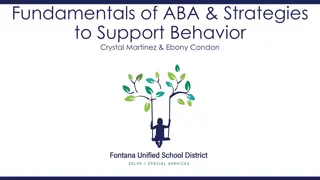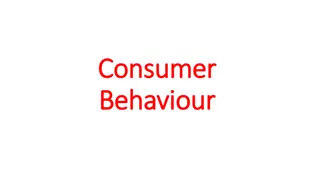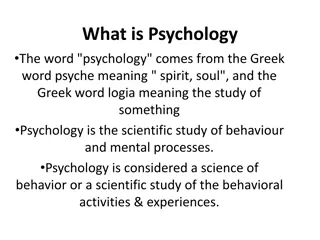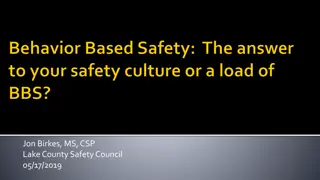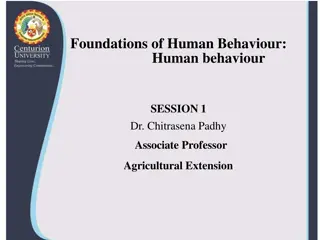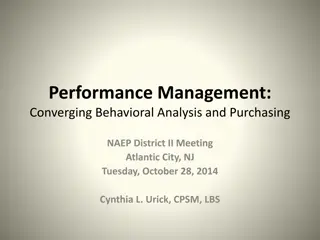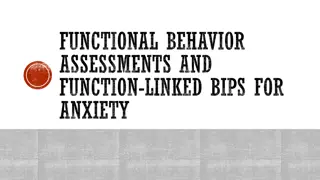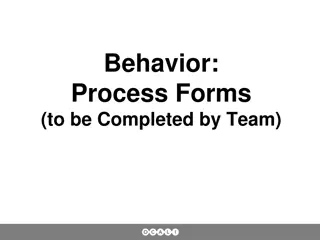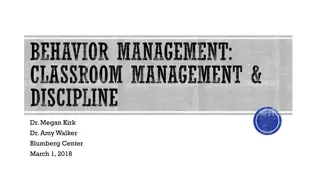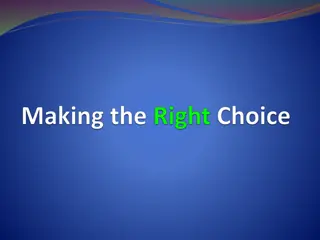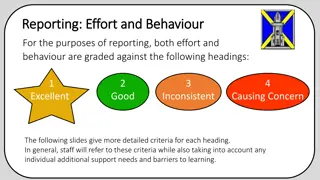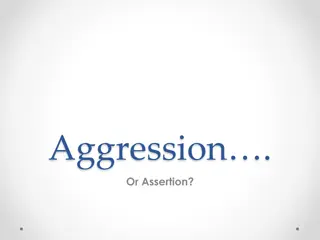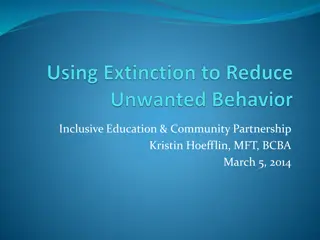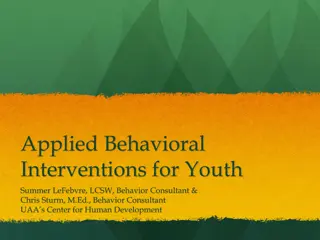Understanding Antecedents and Consequences in Behavior
Explore the importance of identifying antecedents and consequences in behavior management, with insights shared by experienced presenters. Topics covered include reviewing triggers, understanding short-term effects, and methods for data collection. Gain valuable knowledge on behavioral analysis techniques.
Download Presentation

Please find below an Image/Link to download the presentation.
The content on the website is provided AS IS for your information and personal use only. It may not be sold, licensed, or shared on other websites without obtaining consent from the author. Download presentation by click this link. If you encounter any issues during the download, it is possible that the publisher has removed the file from their server.
E N D
Presentation Transcript
Function Fridays for Better Behavior Series Session Three: Antecedents & Consequences You are muted throughout the ECHO session and please use chat or raise your hand to prompt the facilitator when you need to speak. If you are logged in to today s session with another identifier, you can change your name by hovering over your participant video/name box and clicking on the three dots in the upper right-hand corner and choosing rename to change to your first and last name.
Presenters: *Leni Swails, PhD *Alice Zhang, PhD, BCBA-D Katy Tepper, PhD Skylar Bellinger, PhD *Today s presenters
Mitigating Potential Bias The information and recommendations involving clinical medicine is based on evidence that is currently accepted within the profession
Objectives: 1. Review antecedents and consequences 2. Understand big picture and short term antecedents and consequences 3. Discuss ways to collet data and determine relevant antecedents/consequences
Agenda Introductions and Check-In (9:00-9:05) Housekeeping (9:05-9:15) Case presentation volunteers Check in on individual data collection Summary of previous case presentation, follow up questions (9:15-9:25) Didactics (9:25am-9:50am) Brief case presentation (9:50am- 10:00am)
Introductions Briefly State (2-3 sentences): Your Name Where you re from Work Setting/Profession
Housekeeping Case presentations We need YOU! Data collection Please complete the baseline evaluation survey using the link sent to you at the beginning of the series if you have not Let s talk about your own data collection with the identified child
Summary of Previous Case Recap: 5 year old boy, K student Social history: Trauma, limited support at home Behaviors: Aggression, choking self/others, regressed in toileting, shutting down, sexualized behavior Proposed function: task avoidance, gain access to preferred items Triggers: math, morning meeting, handwriting, unstructured time Services: School: OT evaluation, auditory processing screen*, visuals, social skills checklist, walking buddy, choice of breaks, sticker reward chart Outside school: MH case management/treatment, recommended telemed psychology (family declined)
Recommendations, food for thought Recommendations: Repeat FBA to determine underlying function with new regression of behaviors Brief functional analysis in classroom to test out ideas Collect quantitative data, maybe in resource room, also on antecedents and consequences: Use a scale chart to convert qual data to quant Proactive special playtime with an adult first thing in the morning (give attention before he acts out for it) Extra special playtime as a reward in the afternoon Frequent specific praise & use of visuals due to processing difficulties Label emotions and provide visual prompt of alternate coping skills, then walk away
Recommendations, food for thought Food for thought: Trauma impacting memory Change in routine over holidays Remind parent that the child may have behaviors because of difficulty intaking information, rather than defiance/purposeful Parents trauma may increase black/white thinking- communicate often (even short notes) about good things the child did at school Remind parent about development level and impact on current behavior Child may not remember the traumatic event, but may know the story from adults Trauma and methods of getting attention Parent PTSD and avoidance of triggers? Adaptive in some environments, maladaptive in others
Functional Behavior Assessment/ Analysis (FBA) There is always a reason for challenging behavior. Kids find a way to get needs met. Reason = Function Behavior = Communication If a behavior continues, it is usually because it works! Many times, behavior is learned and reinforced unintentionally. Oftentimes, the environment and setting triggers certain behaviors (antecedents). The reactions and responses of others teach and maintain the behavior (consequences).
Functional Behavior Assessment/ Analysis (FBA) Oftentimes, the environment and setting triggers certain behaviors (antecedents) Short term antecedents (immediate) Adult direction Transition between activities Reading work, math problems Teacher talking to another student Loud classroom
Functional Behavior Assessment/ Analysis (FBA) Oftentimes, the environment and setting triggers certain behaviors (antecedents) Big picture antecedents (setting events) Change in family structure, housing Tired, hungry, sick Argument on the car ride to school Medication status
Functional Behavior Assessment/ Analysis (FBA) The reactions and responses of others teach and maintain the behavior (consequences). Immediate consequences: Corrective feedback, attention from adult Reaction from peers, siblings Remove task/take a break Get toy, other preferred item from peer
Functional Behavior Assessment/ Analysis (FBA) The reactions and responses of others teach and maintain the behavior (consequences). Long term consequences: Sent to principal s office Adults reluctant to give directions (punishing for adults!) Peers reluctant to be assertive (punishing for kids!)
Functional Behavior Assessment/Functional Analysis Identify the target behavior Operationally define the behavior Systematic Data Collection Antecedents Consequences Function Based Behavior Support Plan 1. What s maintaining the behavior (making it likely to occur)? 2. How can I address the function in the behavior support plan?
What are the functions of behavior? SEAT Sensory Escape/Avoid Attention Tangible
FAI Interview questions Components: Describe the behavior: what it is like, how often, how long, etc. Potential ecological factors: medication, sleep, eating, daily routine, etc. Determine conditions under which the behavior is most likely and least likely to occur: time of the day, location, person, activities, antecedents Determine the consequences of behavior: attention, escape, tangible, sensory Functional Assessment Interview Form young Child: http://csefel.vanderbilt.edu/modules-archive/module3a/4.pdf
Rating scales FAST: Functional Analysis Screening Tool IFA: Indirect Functional Assessment QABF: Questions About Behavioral Function
IFA 7 Johnny, 5 yr Target behavior: hitting others Home: Mom, aunt 6 5 4 3 2 1 0 Attention Escape Auto Tangible Mom Aunt
Recommendations Use as a preliminary guide Use multiple, relevant informants Follow up with direct observation
Hitting X X Johnny X X X X X X X X X X 2 X 1 X X 1 X X 1 1 X X X 5 1 X X X 1 1 1 9 4 0
Johnny 10 9 8 7 6 5 4 3 2 1 0 Attention Escape Auto Tangible
Video with group participation on suspected A/C https://www.relias.com/resource/abc-data-practice
Recommendations Use open-ended first to guide structured Collect data on at least 5 incidences of target behaviors, across multiple days and settings (where behavior occurs)
Challenges with determining A/C Time/staff available for data collection Availability of child for data collection Low incidence behavior (but high intensity concern!) Preexisting perceptions Interviewing parents
What are your challenges with data collection?
SOLUTIONS for determining A/C Time/staff available for data collection Make it easy! (bean count method, easy/clear data collection form, consistent APP used) Make it consistent (don t reinvent the wheel!) Availability of child for data collection Make friends! Bring in other team members- parent, relatives, paras, etc to share your goal Be creative, and don t undervalue the interview
SOLUTIONS for determining A/C Low incidence behavior (but high intensity concern!) Detailed interview on occurrences Use the data you have- once might be enough SEAT Preexisting perceptions Sensory Know yourself and existing biases Use operational definitions to remove subjectivity Escape/Avoid Interviewing parents Attention Educate parents on functions of behaviors Tangible
What solutions have you used for data collection?
Thank You! See you on Friday, Feb. 28th Function Fridays for Better Behavior ECHO Series Session Four: Prevention



